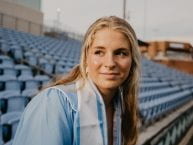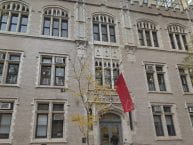We left school at around 3:00 and met Hilary Meltzer in the lobby. We donned on our coats and winter gear and set out for the train station. We were headed to upper Manhattan to Greenpoint so we could take a tour of their water filter. I was a little anxious because I had never taken the G train before and I wasn’t quite sure where it was. When we finally arrived whit Kai’s dad (who we had met in the train) we had to walk a few more blocks. As we got closer, I was able to see in the distance high gates. As we walked closer I saw a colossal factory with very thick tubes running in and out of different buildings. We finally approached the gates and made a right to the visitors center. This is where we met the toure director and the tour began.
I didn’t realize how much work went into having access to clean drinking water, none of the expensive treatment and other bacteria that needed to add to the water for what many of us take for granted. The first step is Primary treatment. This is when larger waste like plastic bottles float to the top and the heavier waste settle to the bottom. The waste team removes this. Once this is separated, it is added it to a landfill. Unfortunately, they do not yet recycle. Then, in the aeration tanks are filled with aerobic bacteria and oxygen that consumes all of the organic waste Then the water flows into the big aeration tanks and is mixed with sludge (which is from the “eggs”) this then stimulates the growth of bacteria and other small organisms that consume most of the remaining organic waste materials that are polluting the water. These organisms and particles grow bigger and heavier since they are filled with food and sink to the bottom of the tanks. This process takes three to six hours. Even after the two previous steps have been completed, there are still diseases causing organisms that still are in the treated wastewater. To kill those harmful organisms, the wastewater spends about 15-20 minutes in tanks filled with chlorine where they are mixed with sodium hypochlorite. This is the same chemical that is found in common household bleach. Then, the treated wastewater is released into our local waterways. With this process, we are making the Hudson River cleaner.
All the sludge and organic waste that I was talking about before is sent to what they call “eggs”. The eggs are kept at 90 degrees Fahrenheit with bacteria that reduces the sludge to a cakey paste and plenty of oxygen so the bacteria can breath. Then it is dewatered and sent off to become compost. This is used for the sludge from the Hudson River as well as for the water treatment plant. The methane gas that the bacteria produce is used to power most of the plant. In a few years, it could power at least half of Brooklyn
Before this trip, I hadn’t really known what the Clean Water Act was. But then my eyes were opened. The Clean Water Act is a federal law in the United States about water pollution. It was passed in 1972 and the point of the Federal Water Pollution Control Act, is to restore and maintain the balanced in the waters by preventing companies from polluting the water directly. The Clean Water Act made it illegal to “discharge any pollutant from a point source into navigable waters, unless a permit was obtained.” Point sources are discrete conveyances such as pipes or man-made ditches. However, individual houses that do not need permits. But industrial, municipal, and other facilities must obtain permits if their discharges go directly to surface waters. This is a very important act because it stops major polluting of big waterways, such as the Hudson River and it might have begun being too toxic to live near.
For people in Manhattan, we are all taught at a young age, that the Hudson River is not something we should swim in or fish in. Almost all the seafood we eat is not from the Hudson River. The Hudson River has been a dumping ground for hundreds of years. At first, everyone dumped everything into the Hudson River. Human Waste, dead animals, the runoff from factories and other toxic chemicals and nobody thought much of it. Meanwhile, just as many beaches are, especially the Coney Island beach was overflowing with tourists, immigrants and regular people, all looking for some fun in the sun. But they began to realize all the gross pollutants that had begun to show up in the water. After that, in 1936 some samples of the Hudson River were taken and it was pronounced polluted. This means that it was unfit to drink, swim in or eat fish from. The water quality has improved since the 1960s. However, the Hudson River is still not fit to swim in yet. But when the sewer system overflows into the Hudson Rivers. But some fish are making a comeback. Before, there was harmful bacteria in the water that stole the oxygen that the fish needed to breathe, but now that all the organic waste is gone so the bacteria is dying out. But harmful pesticides and animal waste runs into the Hudson River, which is what the bacteria thrive on. But we are trying to repair the decline in fish in the Hudson River.
I also learned about the different ways to make New York City More green and to save water for the city and prevent sewer overflow, especially in a storm. The reason this is so important is when it rains, there is a lot more water running into the gutters. This water picks up pollution as it falls of roofs on the dirty concrete and into the gutters. The gutters are designed for only a certain amount of extra water, and the overflow spills into the Hudson River, polluting it even further. The point of these ideas is to delay the amount of rainwater let into the gutters. Some even beautify the city. Some really simple ideas just involve planting more trees and grass that would soak up some of the extra water and beautify our city. Those are infrastructures like Green roofs, Green streets, Right-Of-Way bioswale and Green Infrastructure Playgrounds. But there are other ways in which we can slow down rainwater in order to prevent sewer overflow. Further options such as permeable pavers, blue roofs, cisterns, and porous concrete are ways to delay the water from making it to the sewers.






